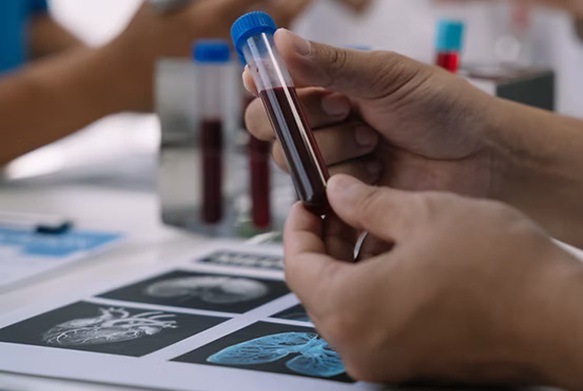AI-Based Digital Pathology Solutions Market Driven by Benefits of More Precise and Reproducible Diagnoses
|
By LabMedica International staff writers Posted on 09 Dec 2022 |

Artificial Intelligence (AI) has been proven to be a faster and more effective approach to identifying and assessing pathological characteristics in samples than previous techniques. The diagnosis process can be accelerated and strengthened by implementing AI. In addition, AI aids pathologists in making accurate diagnoses by using data to verify their findings. It can alert them when their conclusions are contrary to what is expected based on the algorithms. By combining AI with digital pathology as a validation tool, pathologists can now perform image analytics on a more significant number of slides in a shorter period. Pathologists can improve outcomes by focusing on specific regions and improving efficiency accordingly. Digital pathology is also enhancing patient engagement with the use of AI, with devices and apps providing access to electronic health records, radiology images, etc.
The global AI-based digital pathology solutions market is expected to grow at a CAGR of 7.67% during the forecast period 2022-30, driven by the increasing prevalence of diseases, significance of digital pathology for the pharmaceutical industry, and approval by regulatory agencies for the use of digital pathology in primary diagnosis. New business models, such as on-demand services, will play a pivotal role in gaining access to untapped markets and increasing the widespread adoption of digital pathology over the forecast period. Moreover, with digital solutions being highly expensive, solution providers are taking advantage of this problem by setting up regional service centers that will serve the needs of diagnostic labs in the emerging markets through provision of slide scanning and image analysis services and image storage services. These are the latest findings of InsightAce Analytic (Jersey City, NJ, USA), a market research and consulting firm.
With the advent of computational pathology, digital pathology will create opportunities for developing AI-based diagnostic tools that will make it possible to make more precise and reproducible diagnoses. Pattern recognition and generation of perception are essential features of AI. As a result, the integration of AI into digital pathology can provide additional morphological information and features. Digital pathology and AI development are both accelerating at a fast pace, leading to increased interest in computational pathology. AI-based solutions have already been reported to show promising results in detecting prostate cancer.
The launch of new advanced devices by medical device companies is also expected to be responsible for an increase in research into the abilities of AI-based digital pathology as a diagnostic tool for cancer, which in turn will lead to the market's expansion. During the forecast period, digital pathology solutions will continue to drive the growth in market revenue due to their increasing use in drug development and biomarker identification. Nevertheless, the lack of computational analytical tools and high capital investment required to expand internationally will limit market growth. Additionally, the slow rate of technological advancement could hinder the growth of the AI-based digital pathology solutions market.
North America accounts for the largest share of the global market for AI-based digital pathology solutions due to an improvement in healthcare infrastructure, rise in per capita income, and the presence of advanced research institutes and laboratories in the region. The North American market is also being fueled by the continued deployment of R&D investments, implementation of digital imaging, supportive government initiatives, and presence of prominent companies in the region. Another factor contributing to the growth of the North American market is the approval of a digital pathology-focused AI-based tool designed to detect invasive breast cancer and skin lesions for use by AI-based, digital pathology-focused companies.
Related Links:
InsightAce Analytic
Latest Industry News
- Cepheid and Oxford Nanopore Technologies Partner on Advancing Automated Sequencing-Based Solutions
- Grifols and Tecan’s IBL Collaborate on Advanced Biomarker Panels
- New Collaboration to Advance Microbial Identification for Infectious Disease Diagnostics
- Tecan Acquires ELISA Immunoassay Assets from Revvity's Cisbio Bioassays
- Leica Biosystems and Bio-Techne Expand Spatial Multiomic Collaboration
- Philips and Ibex Expand Partnership to Enhance AI-Enabled Pathology Workflows
- Grifols and Inpeco Partner to Deliver Transfusion Medicine ‘Lab of The Future’
- Research Collaboration to Advance AI-Enhanced, Real-Time Optical Imaging in Lung Cancer Biopsy
- CACLP 2025 Unites Global Innovators in IVD Industry
- Bio-Rad to Acquire Digital PCR Developer Stilla Technologies
- ABL Signs Know-How License and Transfer Agreement for Siemens’ Fast Track Diagnostics PCR Portfolio
- Becton Dickinson to Spin Out Biosciences and Diagnostic Solutions Business
- New Partnership Revolutionizes Analyses of Biological Samples
- Medlab Middle East Looks to The Future of Laboratories
- Medix Biochemica Acquires German Immunoassay Solutions Developer Candor Bioscience
- bioMérieux Acquires Norwegian Immunoassay Start-Up SpinChip Diagnostics
Channels
Clinical Chemistry
view channel
‘Brilliantly Luminous’ Nanoscale Chemical Tool to Improve Disease Detection
Thousands of commercially available glowing molecules known as fluorophores are commonly used in medical imaging, disease detection, biomarker tagging, and chemical analysis. They are also integral in... Read more
Low-Cost Portable Screening Test to Transform Kidney Disease Detection
Millions of individuals suffer from kidney disease, which often remains undiagnosed until it has reached a critical stage. This silent epidemic not only diminishes the quality of life for those affected... Read more
New Method Uses Pulsed Infrared Light to Find Cancer's 'Fingerprints' In Blood Plasma
Cancer diagnoses have traditionally relied on invasive or time-consuming procedures like tissue biopsies. Now, new research published in ACS Central Science introduces a method that utilizes pulsed infrared... Read moreMolecular Diagnostics
view channel
Simple Blood Test Better Predicts Heart Disease Risk
Cardiovascular diseases (CVDs) are the primary cause of death worldwide. A large proportion of these cases could be prevented by addressing lifestyle and environmental factors such as smoking, poor diet,... Read more
New Blood Test Detects 12 Common Cancers Before Symptoms Appear
Bowel cancer is the fourth most common cancer in the UK, with over 42,000 new diagnoses each year. Detecting bowel cancer in its early stages can be challenging, and as the disease progresses, survival... Read moreHematology
view channel
New Scoring System Predicts Risk of Developing Cancer from Common Blood Disorder
Clonal cytopenia of undetermined significance (CCUS) is a blood disorder commonly found in older adults, characterized by mutations in blood cells and a low blood count, but without any obvious cause or... Read more
Non-Invasive Prenatal Test for Fetal RhD Status Demonstrates 100% Accuracy
In the United States, approximately 15% of pregnant individuals are RhD-negative. However, in about 40% of these cases, the fetus is also RhD-negative, making the administration of RhoGAM unnecessary.... Read moreImmunology
view channel
Stem Cell Test Predicts Treatment Outcome for Patients with Platinum-Resistant Ovarian Cancer
Epithelial ovarian cancer frequently responds to chemotherapy initially, but eventually, the tumor develops resistance to the therapy, leading to regrowth. This resistance is partially due to the activation... Read more
Machine Learning-Enabled Blood Test Predicts Immunotherapy Response in Lymphoma Patients
Chimeric antigen receptor (CAR) T-cell therapy has emerged as one of the most promising recent developments in the treatment of blood cancers. However, over half of non-Hodgkin lymphoma (NHL) patients... Read moreMicrobiology
view channel
Handheld Device Delivers Low-Cost TB Results in Less Than One Hour
Tuberculosis (TB) remains the deadliest infectious disease globally, affecting an estimated 10 million people annually. In 2021, about 4.2 million TB cases went undiagnosed or unreported, mainly due to... Read more
New AI-Based Method Improves Diagnosis of Drug-Resistant Infections
Drug-resistant infections, particularly those caused by deadly bacteria like tuberculosis and staphylococcus, are rapidly emerging as a global health emergency. These infections are more difficult to treat,... Read more
Breakthrough Diagnostic Technology Identifies Bacterial Infections with Almost 100% Accuracy within Three Hours
Rapid and precise identification of pathogenic microbes in patient samples is essential for the effective treatment of acute infectious diseases, such as sepsis. The fluorescence in situ hybridization... Read morePathology
view channel
Sensitive and Specific DUB Enzyme Assay Kits Require Minimal Setup Without Substrate Preparation
Ubiquitination and deubiquitination are two important physiological processes in the ubiquitin-proteasome system, responsible for protein degradation in cells. Deubiquitinating (DUB) enzymes contain around... Read more
World’s First AI Model for Thyroid Cancer Diagnosis Achieves Over 90% Accuracy
Thyroid cancer is one of the most common cancers worldwide, and its precise management typically relies on two primary systems: (1) the 8th edition of the American Joint Committee on Cancer (AJCC) or ... Read more
Breakthrough Diagnostic Approach to Significantly Improve TB Detection
Tuberculosis (TB) remains the deadliest infectious disease globally, with 10.8 million new cases and 1.25 million deaths reported in 2023. Early detection through effective screening is crucial in identifying... Read more
Rapid, Ultra-Sensitive, PCR-Free Detection Method Makes Genetic Analysis More Accessible
Genetic testing has been an important method for detecting infectious diseases, diagnosing early-stage cancer, ensuring food safety, and analyzing environmental DNA. For a long time, polymerase chain reaction... Read moreTechnology
view channel
Disposable Microchip Technology Could Selectively Detect HIV in Whole Blood Samples
As of the end of 2023, approximately 40 million people globally were living with HIV, and around 630,000 individuals died from AIDS-related illnesses that same year. Despite a substantial decline in deaths... Read more
Pain-On-A-Chip Microfluidic Device Determines Types of Chronic Pain from Blood Samples
Chronic pain is a widespread condition that remains difficult to manage, and existing clinical methods for its treatment rely largely on self-reporting, which can be subjective and especially problematic... Read more




















